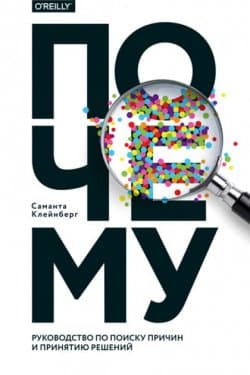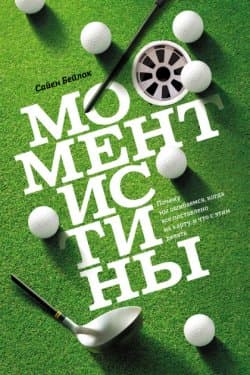Почему - Саманта Клейнберг (2017)
-
Год:2017
-
Название:Почему
-
Автор:
-
Жанр:
-
Язык:Русский
-
Страниц:160
-
Рейтинг:
-
Ваша оценка:
Автор показывает, что такое причинно-следственная связь, поясняет, почему в ее определении мы часто ошибаемся, как можно принимать верные решения. Благодаря этой книге вы научитесь анализировать информацию, выявлять причинно-следственные связи, объединять прошлое, предсказывать будущее.
Книга будет интересна философам, аналитикам, экономистам, медикам, юристам, начинающим ученым.
Почему - Саманта Клейнберг читать онлайн бесплатно полную версию книги
Power, D. J. (2002). Ask Dan! What is the “true story” about data mining, beer and diapers? DSS News, 3(23).
Price, D. D., Finniss, D. G., and Benedetti, F. (2008). A Comprehensive Review of the Placebo Effect: Recent Advances and Current Thought. Annual Review of Psychology, 59: 565–590.
Price, H. (1997). Time’s Arrow and Archimedes’ Point: New Directions for the Physics of Time. Oxford University Press, Oxford.
Prinz, F., Schlange, T., and Asadullah, K. (2011). Believe it or not: How much can we rely on published data on potential drug targets? Nature Reviews Drug Discovery, 10(9): 712–713.
Pritchard, C. (2012). Does chocolate make you clever? BBC News. Retrieved from
Pronin, E., Wegner, D. M., McCarthy, K., and Rodriguez, S. (2006). Everyday Magical Powers: The Role of Apparent Mental Causation in the Overestimation of Personal Influence. Journal of Personality and Social Psychology, 91(2): 218–231.
Psillos, S. (2010). Causal Pluralism. In R. Vanderbeeken and B. D’Hooghe (eds.), World-views, Science and Us: Studies of Analytical Metaphysics, pp. 131–151. World Scientific Publishers, Singapore.
R v. Jordan (1956). 4 °Cr App R. 152.
Radelet, M. L. and Pierce, G. L. (1991). Choosing Those Who Will Die: Race and the Death Penalty in Florida. Florida Law Review, 43(1): 1–34.
Redelmeier, D. A. and Tversky, A. (1996). On the belief that arthritis pain is related to the weather. Proceedings of the National Academy of Sciences, 93(7): 2895–2896.
Reichenbach, H. (1956). The Direction of Time. University of California Press, Berkeley. Reprint, Dover Publications, 2000.
Reiss, J. (2007). Time Series, Nonsense Correlations and the Principle of the Common Cause. In F. Russo and J. Williamson (eds.), Causality and Probability in the Sciences, pp. 179–196. College Publications, London.
Reiss, J. (2014). What’s Wrong With Our Theories of Evidence? Theoria, 29(2): 283–306.
Rescorla, R. A. and Wagner, A. R. (1972). A theory of Pavlovian conditioning: Variations in the effectiveness of reinforcement and nonreinforcement. In A. H. Black and W. F. Prokasy (eds.), Classical Conditioning II: Current Theory and Research, pp. 64–99. Appleton-Century-Crofts, New York.
Rhonheimer, J. (writer) and Fryman, P. (director). (2007). Lucky penny [Television series episode]. In Bays, C. and Thomas, C. (producers), How I met your mother. CBS, Los Angeles.
Ridker, P. M. and Cook, N. R. (2013). Statins: New American guidelines for prevention of cardiovascular disease. The Lancet, 382(9907): 1762–1765.
Robins, J. M., Rotnitzky, A., and Scharfstein, D. O. (2000). Sensitivity Analysis for Selection bias and unmeasured Confounding in missing Data and Causal inference models. In M. E. Halloran and D. Berry (eds.), Statistical Models in Epidemiology: The Environment and Clinical Trials, pp. 1–94. Springer-Verlag, New York.
Robinson, J. W. and Hartemink, A. J. (2010). Learning Non-Stationary Dynamic Bayesian Networks. Journal of Machine Learning Research, 11(Dec): 3647–3680.
Robinson, M. J., Erlwein, O. W., Kaye, S., Weber, J., Cingoz, O., Patel, A., Walker, M. M., Kim, W.-J. J., Uiprasertkul, M., Coffin, J. M., and McClure, M. O. (2010). Mouse DNA contamination in human tissue tested for XMRV. Retrovirology, 7: 108.
de Rooij, N. K., Linn, F. H. H., van der Plas, J. A., Algra, A., and Rinkel, G. J. E. (2007). Incidence of subarachnoid haemorrhage: A systematic review with emphasis on region, age, gender and time trends. Journal of Neurology, Neurosurgery & Psychiatry, 78(12): 1365–1372.
Roser, M. E., Fugelsang, J. A., Dunbar, K. N., Corballis, P. M., and Gazzaniga, M. S. (2005). Dissociating Processes Supporting Causal Perception and Causal Inference in the Brain. Neuropsychology, 19(5): 591–602.
 Почему они не работают? Новый взгляд на мотивацию сотрудников Сьюзен Фаулер
Почему они не работают? Новый взгляд на мотивацию сотрудников Сьюзен Фаулер
 Королевство Аманда Стивенс
Королевство Аманда Стивенс
 Почему Саманта Клейнберг
Почему Саманта Клейнберг
 Момент истины. Почему мы ошибаемся, когда все поставлено на карту, и что с этим делать? Сайен Бейлок
Момент истины. Почему мы ошибаемся, когда все поставлено на карту, и что с этим делать? Сайен Бейлок
 Почему. Руководство по поиску причин и принятию решений Саманта Клейнберг
Почему. Руководство по поиску причин и принятию решений Саманта Клейнберг
 Здравый смысл врет. Почему не надо слушать свой внутренний голос Уоттс Дункан
Здравый смысл врет. Почему не надо слушать свой внутренний голос Уоттс Дункан

 Пир теней
Пир теней  Князь во все времена
Князь во все времена  Когда порвется нить
Когда порвется нить  Пока я здесь
Пока я здесь 



